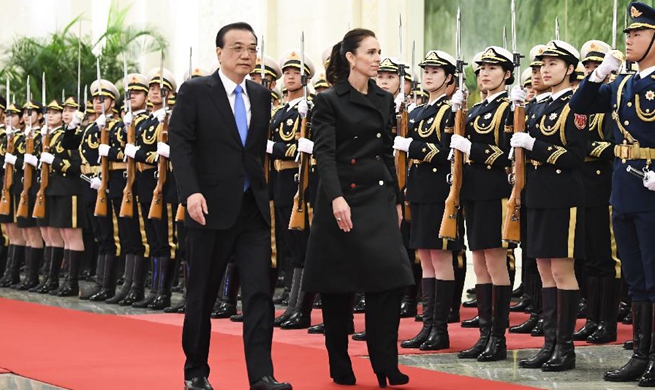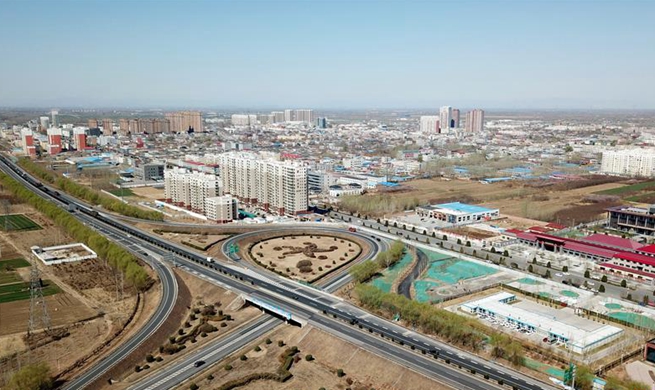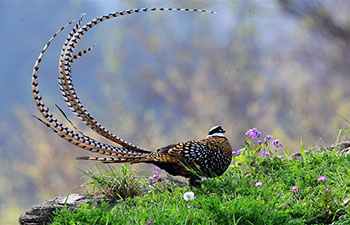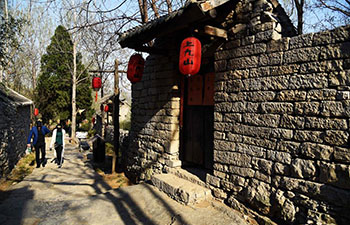by Li Huizi, Lu Huaiqian
WELLINGTON, April 3 (Xinhua) -- When 43-year-old Eric Livingstone, managing director of an animal husbandry company, landed in Beijing in 1984 on a New Zealand Air Force plane after an 18-hour flight, he was exhausted.
"Everyone was in a Mao suit, blue or black. There were no bright clothes, no advertising. The only cars were old Russian cars," said Livingstone, who was among "a gang of 40" as described by New Zealand media, referring to a high-level delegation of company executives and senior officials then to visit Beijing, Nanjing and Shanghai.
Livingstone, who used to be the president of the New Zealand-China Friendship Society, told Xinhua before Saturday's unveiling of the China-New Zealand Year of Tourism that he never foresaw New Zealand tourism would be boosted to such a great extent by a country so different from his own.
BIG CULTURE SHOCK
It was cold, said Livingstone about his first trade mission to China in 1984. He walked around Beijing Hotel, but found it too cold and went back to his hotel room. There he found a thermal flask in his room, which showed the importance of boiled water in China.
During his visit to China, Livingstone was also interested in the stone lions at the gate. Buying silk at the Beijing Friendship Store was another interesting experience, he told Xinhua.
Between 1984 and 1985, Livingstone joined three trade missions to China. Since then, he has hosted many Chinese officials and delegations in Christchurch, the largest city in the South Island of New Zealand, and visited China 17 times over the past 30 years.
When Livingstone and his wife Judy went to Wuwei City in northwestern China's Gansu Province in 1985, few foreigners had been there. As one of the early Kiwi "tourists," he and his wife learned how to crouch on a Chinese squat toilet. They had been invited to Wuwei to advise on animal husbandry and pasture protection.
Over the past 40 years, more and more Kiwi tourists and business people have traveled to China, Livingstone said. Meanwhile, he was "hugely surprised" by the surge of Chinese tourists into New Zealand.
GROWING MUTUAL INTEREST
When Lisa Li started a New Zealand branch of the China Travel Service (CTS) in 2000, China was not a destination for New Zealanders, and visiting New Zealand was also not common for ordinary Chinese people.
Li, managing director of the branch, said New Zealanders still had a stereotyped understanding of China at that time.
With more Chinese students coming to study in New Zealand around 2000, Kiwis started to gain knowledge of China through interactions with these students. China is now New Zealand's largest source of international students and there were more than 40,000 Chinese student enrollments in New Zealand in 2017.
In 2010, Li's company sold about 10,000 Shanghai World Expo tickets in New Zealand, which surprised the expo's organizing committee as that meant a considerable number of people in New Zealand with a mere 4.8-million population were participating in the expo held in a faraway country.
Livingstone said foreigners in China were always "well looked after." He once joined a very long queue at a Beijing railway station in 2000 to get a ticket. He was pushed along the queue to the front by people, and a staff member brought him to the counter and helped him buy a ticket.
"People always help. That's why people want to go back to China. I felt my wallet was always safe in China," he said.
Many years ago when people came back from their first trips to China, they still called China the "Red Dragon" and they still had fear, his wife Judy said. Later Livingstone introduced this big country in courses to some New Zealand business people and his Friendship Society also explained to people what China looked like in reality.
Tourism exchanges between the two countries took place on a large scale after 1999 when New Zealand was included in the first batch of countries gaining the Chinese government's Approved Destination Status (ADS). Rapid growth of Chinese tourists to New Zealand was witnessed after 2010, said Cheng Mingming, a scholar on China-New Zealand tourism exchanges.
In 2012, the number of Chinese tourists to New Zealand surpassed that to Britain, making China the second-largest and most rapidly-growing source of tourists to the country, only behind Australia.
This coincides with the boom of China's outbound tourism driven by the growing middle class over the past decades, when the enthusiasm of visiting Southeastern Asian neighbors expanded to long-haul destinations, Cheng told Xinhua.
YEAR OF TOURISM BECKONS
The 2019 China-New Zealand Year of Tourism was announced by the two country's premiers in 2017 in a bid to build a stronger bilateral relationship and strengthen economic and cultural ties.
"Tourism is a crucial strand in our bilateral relationship, and is a particularly important driver of economic growth," New Zealand Prime Minister Jacinda Ardern said in a welcoming message at Saturday's opening ceremony of the Year of Tourism in Wellington.
There was an 8.8-percent increase in Chinese holiday-makers to New Zealand from 2017 to 2018, and China is New Zealand's second-largest tourism market. The number of New Zealanders visiting China has also reached a new high, Ardern said.
In a congratulatory message for the opening ceremony of the 2019 China-New Zealand Year of Tourism on Saturday in Wellington, Chinese Premier Li Keqiang said that tourism is an important area of China-New Zealand cooperation and a driving force for the two peoples' mutual understanding and friendly ties.
Last year, around 600,000 visits were made between the two countries, including about 450,000 arrivals by Chinese tourists, 38 percent of whom came from the largest cities of Beijing, Shanghai, Guangzhou and Shenzhen, and 55 percent of whom were 25-54 years old, according to New Zealand government figures.
By 2024, the number of Chinese tourists is expected to grow to more than 800,000 arrivals. The Ministry of Business, Innovation and Employment predicts that by 2024, China is expected to overtake Australia as New Zealand's largest source of visitor revenue.
Tourism New Zealand General Manager, New Zealand & Government Relations, Rebecca Ingram said on Saturday that her agency's focus is on ensuring New Zealand remains a desirable destination and a top option for Chinese travelers.
"China is New Zealand's most valuable visitor market. With the highest daily spending of all our visitors and a highly seasonal profile, our Chinese visitors help to spread the benefits of tourism throughout the year," Ingram said.
Cheng said Chinese tourists' preferences are shifting from group tours to self-guided, independent tours. More Chinese women choose New Zealand as an ideal and safe tourist destination. Holidays that include renting cars are increasing among Chinese travelers, and more Chinese visitors are choosing adventure tours. However, they still tend to have relatively short stays in New Zealand.
Nick Jiang, head of the Christchurch-based Hi Travel tourist company, said young Chinese tourists tend to come in small groups such as only two to six people. Many of Jiang's clients chose hiking, skiing, or mountaineering during their New Zealand holidays.
The Year of Tourism could inject new impetus into New Zealand tourism in China's second- and third-tier cities, which have a huge potential to tap into, and boost the confidence of the industry on both sides, Cheng said.
INDUSTRY UPGRADE
The New Zealand government has been boosting marketing in China, and domestically helped New Zealand enterprises to cope with the increase in arrivals of Chinese tourists.
Livingstone said the New Zealand tourism sector needs to learn more about the cultures of the people coming to stay. Hotels are learning to cater to the Chinese tourists, providing some rice and dumplings "but not in a Kiwi way." Signs in Mandarin are a must, like the Japanese signs that were created during New Zealand's Japanese tourism boom in the 1990s.
The introduction of Alipay and WeChat Pay is one of the key measures to facilitate the stay of tech-savvy Chinese visitors.
Stephen Jacobi, executive director of the New Zealand-China Council, told Xinhua the challenge for New Zealand hotels and attractions is to absorb the tourists and to enable the Chinese visitors to have the right experience.
"While the growth is very positive, now we need to focus more of our ability to sustain the growth from China, and that means greater investment in infrastructure," he said.
The Year of Tourism also brings new opportunities for the aviation industry, said Guo Gang, president of Air China New Zealand.
Air China jointly launched a Beijing-Auckland direct link in December 2015 with Air New Zealand. In the same month, China Southern Airlines launched a direct link between Guangzhou and Christchurch to serve the growing number of Chinese visitors to the South Island.
In peak seasons nowadays, there are more than 80 direct flights between New Zealand and China every week, according to New Zealand's Ministry of Foreign Affairs and Trade.
The Year of Tourism also aims to bring more New Zealanders to China, which would help increase Kiwis' understanding of their top trading partner. About 31,400 visits were made by New Zealanders to China in 1999, and the figure increased fivefold to 143,700 in 2017, according to Chinese government statistics.












